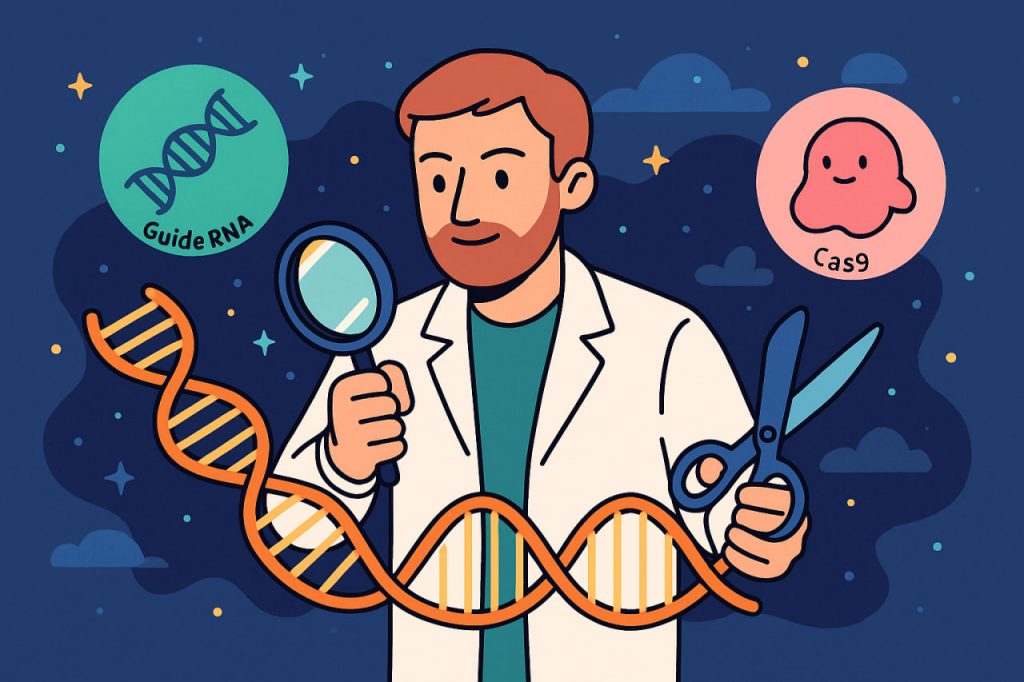In recent years, few discoveries have made as much impact in biology and medicine as CRISPR. This groundbreaking gene-editing technology gives scientists the ability to cut, remove, replace, or modify DNA sequences with unprecedented precision. CRISPR holds promise for treating genetic disorders, fighting infections, and even curing cancers. It may redefine the future of personalized and regenerative medicine.
What Does CRISPR Stand For?
CRISPR is short for:
Clustered Regularly Interspaced Short Palindromic Repeats
These are specific segments of DNA found in bacteria, which act as a kind of immune memory system. Bacteria use them to store viral DNA fragments from past infections. When the virus reappears, the bacteria use these records to recognize and destroy it using a protein called Cas (CRISPR-associated protein), like Cas9 — the most widely used version.
How CRISPR Works in Gene Editing
- Guide RNA is created to match the specific DNA sequence to be edited.
- This guide is combined with the Cas9 protein, which acts like molecular scissors.
- The complex is inserted into the target cell.
- Cas9 cuts the DNA at the chosen site.
- The cell attempts to repair the break, and this process can be used to:
- Disable a malfunctioning gene
- Insert a corrected version of the gene
- Modify gene expression patterns
CRISPR is faster, cheaper, and more accurate than previous gene-editing technologies.
Applications of CRISPR in Modern Medicine
1. Treating Genetic Diseases
CRISPR can be used to target inherited mutations, such as:
- Sickle cell anemia
- Cystic fibrosis
- Huntington’s disease
- Muscular dystrophy
Some clinical trials have already shown success in reversing symptoms by editing patients’ blood stem cells.
2. Fighting Cancer
- CRISPR is being used in immunotherapy to enhance the ability of immune cells (like T-cells) to recognize and attack tumors.
- It can disable cancer-protecting genes inside tumor cells, making them more vulnerable to treatments.
3. Antiviral Therapies
- Researchers are using CRISPR to target and destroy viral DNA inside human cells — such as HIV, herpes, and even SARS-CoV-2.
- Unlike vaccines, CRISPR could potentially eliminate viruses already inside the body.
4. Organ and Tissue Engineering
- CRISPR is also used in gene-edited pigs to make organs safer for human transplants.
- It can assist in growing personalized organs using stem cells.
Ethical Concerns and Risks
While CRISPR is powerful, it raises serious bioethical questions:
- Off-target effects: Cas9 might cut the wrong DNA site, causing unintended consequences.
- Germline editing: Changes made to embryos or reproductive cells are inherited — raising concerns about designer babies or long-term mutations.
- Equity: Will access to gene editing be limited to wealthy populations?
- Consent: Can unborn individuals consent to genetic changes?
In 2018, a scientist edited human embryos in China, leading to global outcry and calls for stricter regulation.
The Future: What Lies Ahead?
CRISPR is advancing rapidly, and scientists are working on next-gen tools like:
- CRISPR-Cas12 and Cas13 — more accurate and useful for RNA editing
- Base editing — rewriting single DNA letters without cutting the strand
- Prime editing — even more precise edits without major breaks
In the coming decades, CRISPR could become a routine part of medicine, offering personalized cures and possibly preventing inherited diseases before birth — if society agrees on the ethical framework.
Glossary
- CRISPR: A gene-editing tool based on a bacterial defense system
- Cas9: An enzyme that cuts DNA at targeted sites
- Gene editing: Changing the DNA sequence in a cell
- Germline: Cells that pass on genetic information to offspring
- Immunotherapy: Treatment that uses the body’s immune system to fight disease


